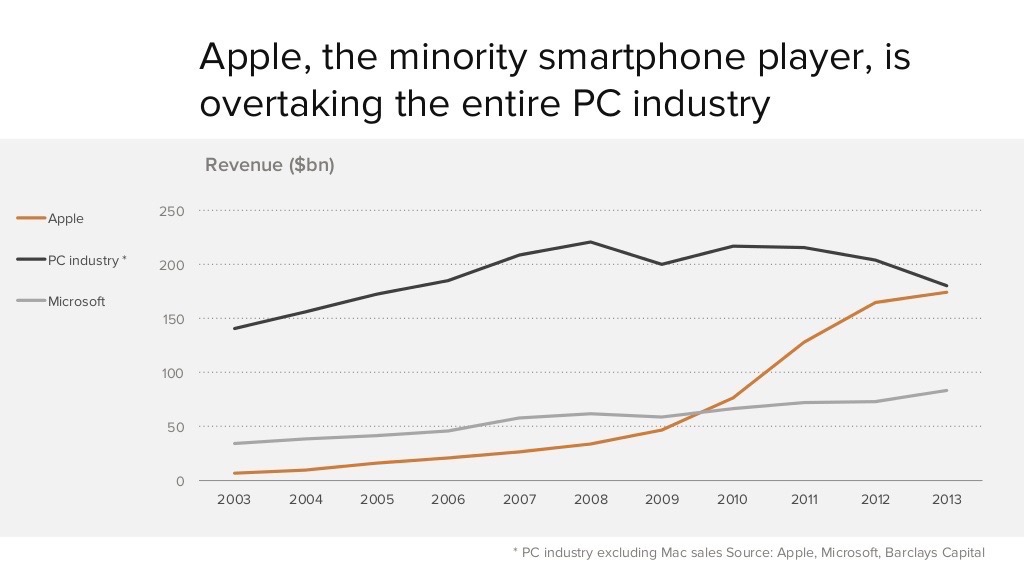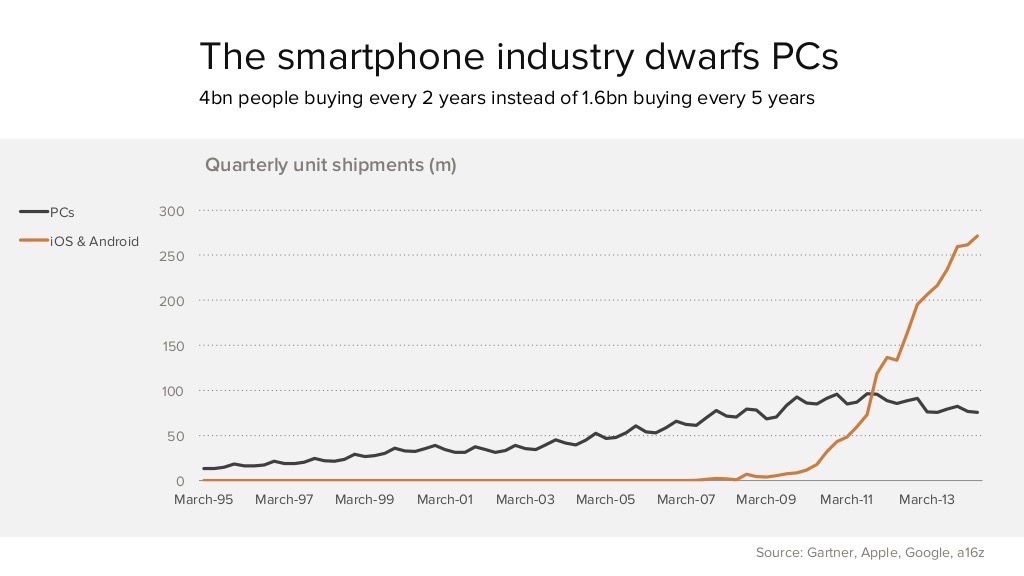
I’ve been staring at the above chart and I think there’s a lot we can learn from it.
1) Facts
1.1) Desktops are used most during working hours and their usage tails off at night.
1.2) Tablets are used least during working hours but their usage rises sharply at night, eclipsing even the usage of phones.
1.3) Phone usage remains almost constant both during working hours and after hours and pretty much throughout the time that we remain awake.
2) Speculation
2.1) Desktops are work machines, yes, but more and more they are becoming work only machines. As time goes on, I expect the pattern shown in the above chart to remain about the same but I expect the usage line to slowly sink lower and lower as desktops are overwhelmed by both tablets and especially by phones.
I wrote about this last week, but I don’t think many people realize how rapidly desktops are being eclipsed by tablets and and phones. This is because the raw number of desktops is remaining about the same but, as a percentage, the desktop’s share of the overall computer pie is rapidly shrinking.


Those of us who own desktops just don’t realize just how many new computer users never have — and never will – use a desktop computer in their lifetimes.
2.2) Tablet usage is lowest during working hours and highest during the evenings. I expect this pattern to remain about the same too but I expect the usage line to gradually rise as the desktop line gradually sinks. It’s not that tablet are replacing desktops. Tablets may take over the tasks of some very low-level desktop machines, but for the most part tablets are creating new computing jobs, not replacing the old computing tasks.
For example, Ben Bajarin wrote an article in which he talked about tablets taking over all the tasks that used to be done by clipboards. Think about that for a second. There are so many tasks that simply cannot be done by a desktop or notebook computer but can be easily accomplished by a tablet. Any task that should be done while standing favors the tablet over the desk bound desktop and notebook. As time goes on, we will continue to expand computing into areas where the desktop form factor previously made their use impractical.
2.3) Finally, the phone. The phone revolution began only seven years ago when the iPhone was introduced in 2007. Its a supercomputer in our pockets that we have access to all day long. And, according to the usage statistics, that’s exactly how we use it — all day long.
I expect the usage line for phones to continue to rise but only slowly. We are already using our phones in short bursts throughout the day. At some point, we’re going to max out. But that day hasn’t arrived yet.
More importantly, as Benedict Evans likes to point out, pretty soon almost every man, woman and child across the globe is going to have a supercomputer in their pocket. We need to think about this more if we want to comprehend the future of computing. What will it mean for everyone to be connected everywhere at any time? I think the ramifications are huge although my limited imagination cannot yet see what those ramifications will be.
Conclusion
The rules of computing are changing right before our eyes. It’s like playing chess but the pieces no longer move and act the way they did before.
The role of the desktop computer will continue to baffle many. It will remain the King of the computer chessboard but now the King is no longer the most important piece. To those who need power, the desktop will remain powerful. To those who don’t need the power of the desktop, the desktop will remain irrelevant. It’s a paradox that many can not — or will not — comprehend.
The tablet will be the Knight on the computer chessboard. Not as powerful as the desktop, but able to do things and go places that the desktop can not.
And the smartphone will be both the Pawn and the Queen of the computer chessboard. Simultaneously ubiquitous and powerful. Imagine playing chess with eight Queens. Now imagine a world where everyone has the power of computing with them at all times.
The pieces on the computing game board have changed. The way we play the game will be changing too.

Where does this leave notebooks / laptops? I’m assuming they can be lumped in together with desktops?
Notebooks and laptops are far more like desktops than like tablets. They have almost all the power of the desktop but they gain mobility at the cost of screen size.
I’ve often tried (in my mind) to create a formula that would capture the computing world in which we live. It would go something like this.
— Phones for when we’re on the go.
— Tablets for when we’re going and stopping and going again.
— Notebooks for when when go then stop.
— Desktops for when where we are is where we’re going to stay.
It doesn’t quite work, but I think it’s close. Mobility is the key differentiator in most products.
In my mind input is the other. The notebook and the desktop are more alike than different. The tablet and the phone are more alike than different. The notebook/desktop and the tablet/phone are more different than alike. The user input makes all the difference.
Very interesting take. I wonder if in a few years time we arrive at a situation where the tablet becomes capable enough, in terms of performance / features, that it could supplant the laptop so you’re left with the following;
Phones
Tablets
Desktops
“I wonder if in a few years time we arrive at a situation where the tablet becomes capable enough, in terms of performance / features, that it could supplant the laptop” – Shameer Mulji
Maybe, but I don’t think so. I think the tablet and the notebook are two entirely different beasts. The tablet wants to be touched. The Notebook thrives with pixel input. That requires a keyboard and a mouse or stylus. Mixing the two inputs leads to unsatisfactory results as both Windows 8 and the Surface have demonstrated.
I’m not sure the jury’s out on that.
1- The Metro UI issues were not really related to mixed mode. I found it rather good for touch, and OK for kb+ms. The main issue was lacking discoverability, but Android and iOS have the same issue: possible actions are often not shown (scrolling, gestures…)
2- the main issue is it was sorely lacking apps and depth, but that’s not an intrinsic issue, that’s MS drones rushing a product to market to meet deadlines instead of thinking of customers.
2- the other main issue is that it was different (and, again, not very discoverable), so people who were doing stuff by rote on the desktop UI just got lost in Metro.
3- Android has keyboard and pointer (mouse, trackpad, gyroscope…) support. It’s quite OK, and what needs improving (keyboard shortcuts, we all miss ctrl-alt-cokebottle and right+wheel mouse button actions) can be w/o any interference with touch mode.
“I’m not sure the jury’s out on that.” – obarthelemy
I think the Jury is out, came back, read the verdict, went home and are sitting on their couch playing games and watching videos on their tablets.
But we’re allowed to disagree. 🙂
Well, if the jury’s out, it is in favor of Android tablets, who do support pointers, and who grabbed market share even more quickly than in the phone segment. Similarly, Surface tablets are not faring quite as badly as Windows phones (if damning with faint praise counts ^^).
I think some of the jury have plugged in a keyboard and a mouse, and are working on that book and their expense report :-p
That’s a very interesting point. It would require having breadth of software in tablets to cover what’s available in laptops. Currently that means Win8 tablets. Personally, I prefer the hybrids. In my house are an original Yoga, a Vaio Pro 13, and a Surface Pro 3. I like them all, but I only find myself using Metro only for consumption.
I have a lot of Android tablets, and there’s even an iPad in the house (wife). I find I use them only for light duty as well. My Android phones get used more than my tablets, if for no other reason, I always have them on me.
I always carry two phones. I recently exchanged an LG G3 for a Nokia 1520. It’s a really nice device. Too bad WP8 is not getting more traction.
It does seem that large phones can readily substitute for tablets.
Your formula misses talking about power. Both the power to drive the CPU (and other components) in the device and the power of the CPU to do work. Battery power on a smartphone or tablet is good for their intended uses but try and use one as like a laptop and watch the battery die within a few hours.
Having a MacPro means that I have all the CPU performance I’m likely to need for the near future but the job to done doesn’t include anything away from a single desk. Also, it is easier to get decent performance at a lower price than a mobile device with a battery and usually constrained heat dissipation. Those characteristics are probably the only reason that desktop machines exist at all. If money and performance weren’t at stake, then notebooks would cover 100% of the needs for desktop and portable use.
Phones and tablets are in a different category where mobility and ubiquity trump power. I don’t know if we will ever get parity between notebooks and tablets. Even if we do, it is possible that they don’t converge because they perform different jobs–it is hard to predict. And smartphones are likely here to stay in their own category unless wearables take over the world.
It really depends on which phone you’re talking about. Some phones are good for 2-3 days of regular use, and 1 day of very intensive use.
I don’t entirely agree with your theory of power. I believe, as Mr. Kirk put it, that input the other critical metric.
Where there’s complex input processing power and gross amounts of RAM will be required. This is where the input metric, that’s not accounted for, is important. If the average metric is Facebook, web browsing, Netflix and email are the primary functions than an AlienWare 64GB RAM, 100TB HDD, 100-core nitroglycerin-laced rig will be wasted. Like buying a Peterbilt for a soccer mom.
I think battery life is a factor to separate tablets from notebooks in determining mobility. Most laptops in use today (i.e., circa 2009+) have a very short battery life and are highly portable but not really mobile.
Do you know the source of the first graph? I’m curious about the dimmed lines.
Otherwise, it seems to closely resemble the pattern that Chitika reported on a year and a half ago.
http://chitika.com/browsing-activity-by-hour
I grabbed the image off of Twitter. Here is the link:
https://twitter.com/Chartbeat/status/528200933386510336
It appears to be from Chartbeat and it appears to be of recent origin but when you follow it to its source it leads you to an on-demand quarterly report.
http://lp.chartbeat.com/quarterly-0102.html?utm_source=twitter&utm_medium=organic%20tweet&utm_campaign=2014%20Q3%20Quarterly%20Report
Thanks. Dug a little deeper and it seems to come from this presentation. Haven’t yet had time to listen to it though.
http://youtu.be/VZ-lkVla5Eg?t=10m13s
“And the smartphone will be both the Pawn and the Queen of the computer chessboard.”
Wonderful analogy. I think today we have Queens, Bishops, Rooks and Pawns in phone usage:
Queen: Superphones (perhaps I’m coining a new term here): e.g., iPhone 6Plus/Galaxy Note 4
Bishops & Rooks: Smartphones
Pawns: Feature & feature-less phones
Users, depending on their individual purchasing power are moving up from pawn-to-rook/bishop-to-queen. Technological progress and the proliferation of cheap smartphones will eventually put a supercomputer in the hands of 6+ billion people.
That is an almost incomprehensible thought!
“The rules of computing are changing right before our eyes.”
This is the typical “tech pundit’s” dilemma: They cannot understand what they see through their geeky eyes. I am glad that you, John, don’t have that kind of eye.
“The pieces on the computing game board have changed. The way we play the game will be changing too.”
Most “tech pundits” can only prognosticate on market trends based on the players never changing how they play the game. They are “at sea” when the way the game is played changes also.
Some really excellent info, I look forward to the continuation.